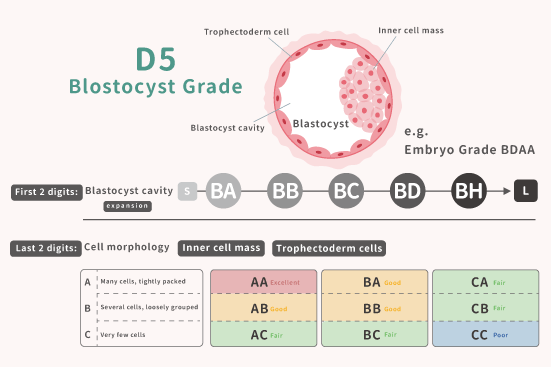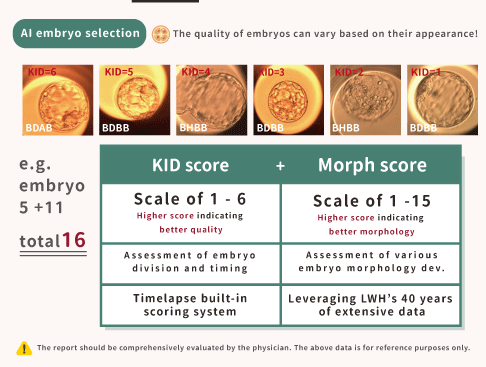Knowledge Sharing
2023.07.06
Embryo Grading & AI Embryo Selection: Embryo Grading Scale
Why do embryos need to be graded?
Patients undergoing IVF are most concerned about whether their embryos are good enough to have a chance of implantation. Based on clinical observations, most failed implantations are related to embryo quality. In addition to preimplantation genetic testing (PGT-A), how do embryologists assess embryo quality and assign blastocyst grades? After fertilization, embryologists determine the quality of the embryos through regular observation of their “morphology”, which is the basis for assessing the quality of IVF embryos. This is why patients often come across the grading system of ABC levels on the internet. Doctors use embryo grading to predict the success rate of embryo implantation, with higher-grade embryos having a higher chance of successful implantation.▲[EN sub] Embryo Grading Explained
Watch on YouTube, turn on auto-translate for English subtitle
Embryo Grading and AI Embryo Selection
Classify Embryos Based on Days of Development
In natural conception, after the egg and sperm fuse and combine into an embryo in the fallopian tube, it undergoes cell division while moving towards the uterine cavity. Implantation on the uterine lining usually occurs around the 7th day after fertilization. In IVF treatment, embryologists observe the developmental status of the embryos on days 1,3, and 5, and select the appropriate timing for embryo transfer based on the embryo grading on day 3 or day 5.What is the difference between day 3 and day 5 embryos?
Day 3 embryos are cleavage-stage embryos, which typically consist of 6 to 8 cells. Day 5 embryos, on the other hand, are blastocysts, consisting of an outer layer of trophoblast cells and an inner mass of cells called the inner cell mass. Different stages of embryonic development are graded using different methods, and embryo grading serves as one of the indicators for predicting the success rate of implantation and pregnancy.Day 3 Embryo Grading
| Number | First Letter | Second Letter |
|---|---|---|
| Cell count | Cell Symmetry | Cell fragmentation |
In the grading system for Day 3 embryos, the number represents the count of blastomeres, which ideally should be 6-8 or more.
The first letter indicates the symmetry of the cells and has two grades:
- A: Uniform cell size
- B: Varying cell sizes
The second letter represents the presence of fragments surrounding the cells (fragmentation) and has four grades:
- a: Excellent, no fragments or fragments occupying less than 5%
- b: Good, fragments occupying 10%-20%
- c: Fair, fragments occupying 20%-50%
- d: Poor, fragments occupying more than 50%
For example, the embryo grade 8Aa indicates that the embryo has 8 cells, with uniform cell size and very few fragments, making it a good-quality embryo. During the early stages of embryonic development, cellular fragmentation tends to have lower grades, which can affect their development and may also indicate chromosomal abnormalities in the embryos.
Day 5 Embryo Grading
| First 2 Letter | Third Letter | Fourth letter |
|---|---|---|
| Expension of cavity | Inner cell mass | Trophectpderm |

The first two letters represent the grade of expansion of the blastocyst cavity:
From small to large, they are classified as BA (1), BB (2), BC (3), BD (4), BH (5 or 6). When performing preimplantation genetic testing for aneuploidy (PGT-A/PGS) on blastocyst biopsy, the size of the blastocyst cavity expansion should also be considered, with a requirement of at least 150μm (micrometers) or more, which corresponds to the BD or BH grade of blastocyst expansion.
The third letter represents the grading of the inner cell mass (ICM morphology):
- A: Many cells, tightly packed
- B: Several cells, loosely grouped
- C: Very few cells
The fourth letter represents the grading of the trophectoderm cells (TE morphology):
- A: Many cells, tightly packed
- B: Several cells, loosely grouped
- C: Very few cells
Higher Embryo Grading, Better Success Rate
A higher grade of blastocyst quality can be associated with a higher expected rate of successful implantation and indicates a better developmental morphology of the embryo.| Excellent embryo | AA |
|---|---|
| Good embryo | AB, BA, BB |
| Fair embryo | AC, BC, CA, CB |
| Poor embryo | CC |
Research has shown that embryo grade is related to the rate of chromosomal normality in embryos of the same age. Higher embryo grades are associated with higher rates of chromosomal normality. However, embryo grade is not directly correlated with the success rate of IVF. If the obtained embryo grade is not ideal, it is still advisable to discuss it with your attending physician, as every embryo is valuable.
Day 3 or Day 5 embryo transfers? Do day 5 embryos have a better success rate?
In the old days, embryos were often transferred on the third day (Day 3) because the uterine environment was considered more suitable for embryo development than the artificial environment of the incubator. Additionally, some embryos may not be able to reach the blastocyst stage on the fifth day (Day 5) of in vitro culture. Transferring embryos on the third day aims to improve the chances of successful implantation.However, transferring embryos on the fifth day (Day 5) offers advantages such as reducing the risk of multiple pregnancies and ectopic pregnancies. Furthermore, it allows for preimplantation genetic testing for aneuploidy (PGT-A/PGS) or preimplantation genetic testing for monogenic disorders (PGT-M/PGD) to identify embryos with chromosomal abnormalities.
With the continuous advancement of assisted reproduction technologies, Lee Women’s Hospital’s embryologists now optimize the culture conditions in stable temperature and humidity incubators, simulating the natural environment of the fallopian tubes and uterus. This enables more embryos to reach the blastocyst stage on the fifth day of in vitro culture, providing physicians and patients with more options during the IVF treatment process.
AI Embryo Selection Technology for more precise embryo grading

Lee Women’s Hospital’s IVF Lab continues to make breakthroughs in AI-assisted IVF technologies. In addition to the Time-Lapse embryo imaging system, we utilize our extensive accumulated data over 40 years, combined with AI technology, to make embryo selection faster and more accurate.
When embryos have similar external appearances, the AI embryo selection system can further identify embryos with higher success rates for implantation. This allows physicians and embryologists to determine if the embryos’ division and timing are normal and if they exhibit favorable development in various embryo morphologies before the implantation process.




